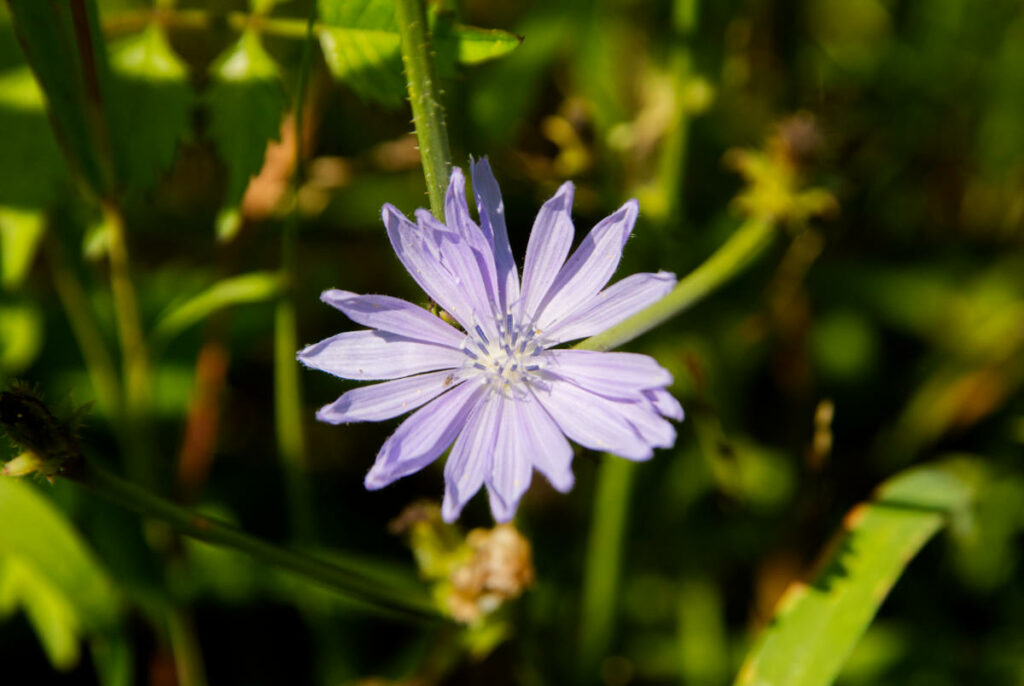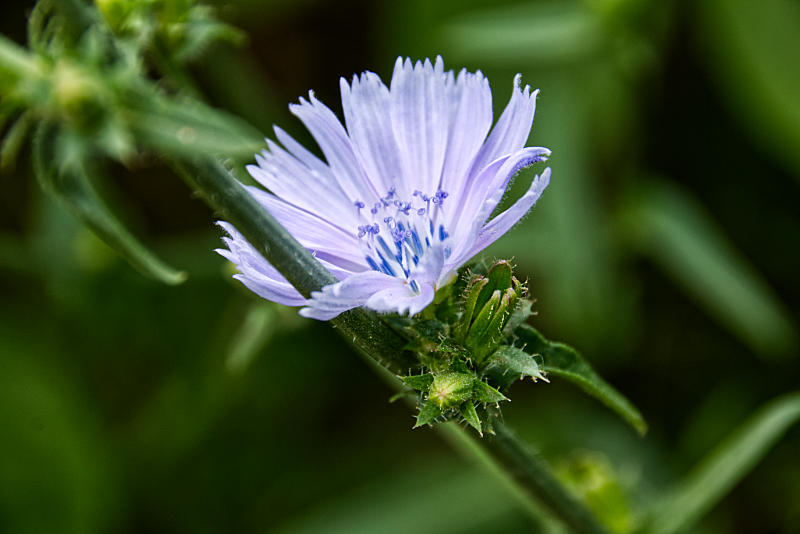
Ah, chicory! The plant that’s both bitter and sweet, like that ex you can’t quite forget. But don’t worry, this article won’t make you feel bitter – we’re here to celebrate the versatile and underappreciated chicory. From its use in coffee to its culinary applications, we’ll cover everything you need to know about this humble plant.
So, what is chicory? At its core, chicory is a leafy plant that’s a member of the dandelion family. It’s often used as a coffee substitute, but that’s not all it’s good for. This article will explore the history, uses, and health benefits of chicory, as well as provide some delicious recipes that will make you fall in love with this underdog of the vegetable world. Keep reading to find out why chicory deserves a spot in your kitchen and on your plate!
Have you been driving in the Ozarks and noticed all the light blue flowers blooming along the highways and in the pastures? That, my friends, is common chicory. Yes, that chicory. The name is famous if you have ever visited New Orleans and had the popular coffee with chicory they serve down there. Have you ever wondered what that is that they add to the coffee? Read on to find out about this amazing plant that is blooming all over the Ozarks right now.
What Is Chicory?
Chicory (Cichorium intybus) is a plant in the same botanical family as the dandelion, Asteraceae. It has pale blue flowers on upright stems. The flowers can sometimes be purple, or lavender, and rarely they can be pink or white. Other common names include blue dandelion, blue daisy, cornflower, blueweed, or coffee weed. They flower from July through October.
Chicory is native to Europe, Asia, and West Africa. It was imported into the United States and became naturalized. It can be found growing along roadsides and in pastures. In some areas, it is grown for livestock forage.
There are mentions of the use of Chicory in the historical record as far back as the Egyptians and Romans. For more information, you can read about it here.

How Is Chicory Used?
Roots
Probably the most commonly used part of Chicory is the root. During tough economic times, the root was roasted and used as a coffee additive or substitute. Before the Civil War, the port of New Orleans was the second leading coffee importer, behind only the port of New York. During the Civil War, Union naval blockades prevented imports, so the residents began adding chicory to the coffee to extend it. This began a tradition that endures into the modern era. Confederate soldiers also used the roots as a coffee substitute when supplies of coffee ran out. You can still make a slightly bitter coffee substitute by collecting and roasting the roots, then grinding them like you would coffee beans.
In modern times food scientists discovered that the roots contain inulin. Inulin is a prebiotic fiber found in many of the foods we eat. Prebiotic fiber in your diet helps to nourish probiotic bacteria in the gut. Consuming the root can be very beneficial to the health of your digestive system.
Chicory root contains up to 40% inulin. Dietary fiber is good for your digestive health. The primary type of fiber in the root is soluble fiber. This type of fiber helps to slow digestion, may help to regulate blood sugar levels, and can reduce cholesterol levels. Foods high in fiber have been shown to help prevent cardiovascular disease, and lower the risk of Type 2 diabetes, cancer, and help lower the risk of obesity.
Some food manufacturers began adding the root to help add to the amount of fiber in their products. Since this is a good fiber for you, it helped them to advertise their products as having more nutritional fiber.
Leaves
Chicory leaves are also edible, just like dandelion leaves. In the first year, the plant grows a rosette of leaves low to the ground that look very similar to dandelion leaves. Just like dandelions, the leaves become bitter as they get older. This is due to the sesquiterpene lactones, lactucin, and lactucopricin. If you read our article about wild lettuce you may remember that lactucin is what gives wild lettuce its pain-relieving properties. It is contained in the white, milky latex of wild lettuce. It is also contained in the latex of chicory, although at much lower concentrations.
The leaves can be used in cooking the same as dandelion leaves. They can be added to salads raw, cooked into dishes, or alone by cooking in olive oil or bacon grease and then seasoning with red pepper and salt. I’m sure you can think of many other ways to prepare them.
The best time to gather the leaves is in the early spring. At this time the young leaves are less bitter and actually quite mild. As they get older it may be necessary to boil the leaves and discard the water a few times to make them less bitter. You can then add them to other dishes.
Now that you know what those beautiful pale blue flowers are blooming this time of year in the Ozarks, why not head out and gather some leaves or roots and try out some ways to use this natural bounty for yourself?
You can also grow chicory fairly easily in your garden. You can purchase seeds here.
As with any wild plants make sure you can identify them confidently before you go out on your search. They may cause allergies in some people, so it is best to try a small amount before adding them to a meal.
For more information about other wild medicinal plants and essential oils, you can visit our list of articles.
Disclaimer: This article should not be construed as medical advice. The health information in this article is not intended to assess, diagnose, prescribe, or promise a cure for any medical condition. Consult with your health care professional before considering any natural supplement or plant remedy for your health and wellness. We assume no liability for the use or misuse of the material presented above. Always consult with a medical professional before changing your diet, or using manufactured or natural medications.
FAQs:
Q: Why do they put chicory in coffee?
A: Chicory is often used as a coffee substitute or additive because it has a similar flavor profile to coffee, but is much cheaper. It was originally used in times of coffee shortages and has since become a popular ingredient in many coffee blends.
Q: Who should not drink chicory?
A: People who are allergic to chicory should avoid consuming it. Additionally, those who are sensitive to caffeine may want to limit their intake of chicory, as it can contain trace amounts of caffeine.
Q: Is eating chicory good for you?
A: Yes, eating chicory can be good for you! It is low in calories, high in fiber, and contains several vitamins and minerals, including vitamin C, potassium, and calcium.
Q: What does chicory do for the body?
A: Chicory has been shown to have several health benefits, including improving digestive health, reducing inflammation, and aiding in weight loss. It may also have potential benefits for the liver, heart, and immune system.
Q: Does chicory taste like licorice?
A: Chicory has a slightly bitter, earthy flavor that is often compared to coffee. While some people may detect a hint of sweetness, it does not taste like licorice.
Q: Does coffee taste better with chicory?
A: This is a matter of personal preference. Some people enjoy the added depth and complexity that chicory brings to coffee, while others do not care for the bitter taste. It’s worth trying for yourself to see if you like it!
Q: Is chicory sweet or bitter?
A: Chicory has a slightly bitter taste, which can be balanced out by pairing it with sweet ingredients or flavors.
Q: What can you do with chicory?
A: Chicory can be used in a variety of ways, including as a coffee substitute or additive, in salads and sandwiches, as a cooked vegetable, or in soups and stews.
Q: How do you cook chicory?
A: Chicory can be boiled, steamed, roasted, or grilled. It is often served sautéed with garlic or onions, or paired with sweet ingredients like honey or balsamic vinegar.
Q: How do you eat fresh chicory?
A: Fresh chicory leaves can be eaten raw in salads or used as a substitute for lettuce in sandwiches. The root can also be boiled or roasted and used as a coffee substitute or additive.
Q: Is chicory eaten raw or cooked?
A: It can be eaten both raw and cooked, depending on the dish and personal preference. The leaves are often eaten raw in salads, while the root can be boiled or roasted and used as a coffee substitute or additive. Cooked chicory can also be served as a side dish or added to soups and stews.

